After Ceres explodes (because, as we’ll find out, that what happens to every place Samus Aran ever visits), the scene moves to planet Zebes, setting of the original Metroid. This makes sense, given that Samus just faced down Space Pirate commander Ridley and would naturally think to track him back to his hideout… or at least it made sense back in 1994, before Nintendo had crammed a bunch of other games featuring Ridley on all sorts of other planets into the timeline between the first and third chapters of the series.
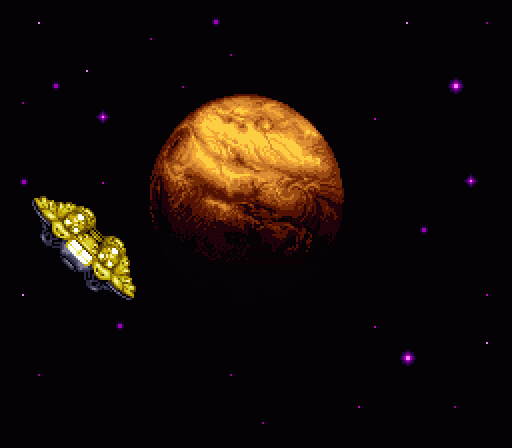
The tragedy of retcons notwithstanding, Samus’ arrival on Zebes heralds the beginning of one of the most subtle, most atmospheric pieces of storytelling-through-game-design ever. We land on the surface of Zebes, with Samus’ gunship in “park” much as we saw at the beginning of Metroid II.
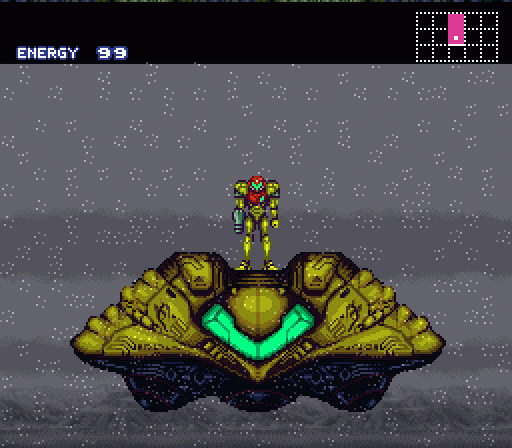
This setup will prove to be very different in nature than Metroid II, however. Samus will return to the surface (and thus her ship) several times over the course of the adventure, making this area a sort of safe haven. The landing zone itself is a sort of densely packed puzzle full of secrets and alternate passages that can be unravelled as you progress through her power-up regimen — a sort of proving ground for skills and some very advanced techniques.
For now, however, the surface of Zebes is silent but for rain and distant, muffled thunder. There’s no musical accompaniment here, only the sound of the bleak weather.
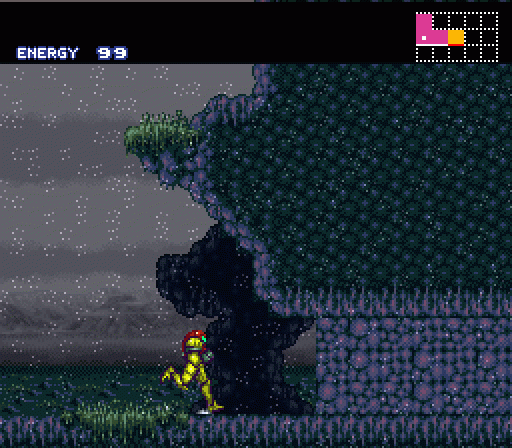
And there’s not much you can do yet, either. If you head to the right (as you did in Metroid II), you’ll quickly find Samus stymied by the presence of a barrier wall. It looks artificial and wholly destructible, but since all you have at the moment is the standard pea-shooter, there’s nothing doing here. The wall overhead is deliberately curved inward into the landing site — something a first-time player wouldn’t notice, but someone versed in Samus’ secret innate skills would. There’s no sequence-breaking to be had here. Not yet.
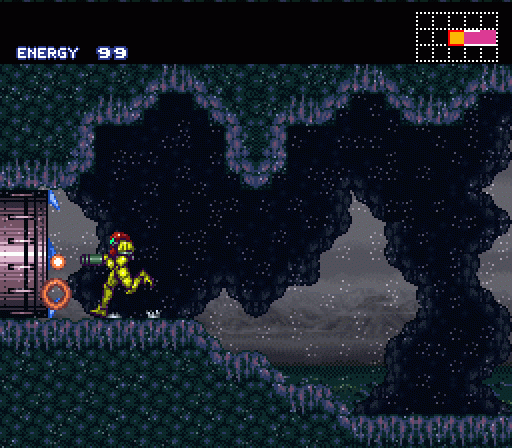
A door to the left takes you from the planet’s surface to the interior. Because this isn’t peaceable Ceres Station (R.I.P.), the door doesn’t open automatically for you; you have to shoot the Metroid-style blue bubble to open the passage.
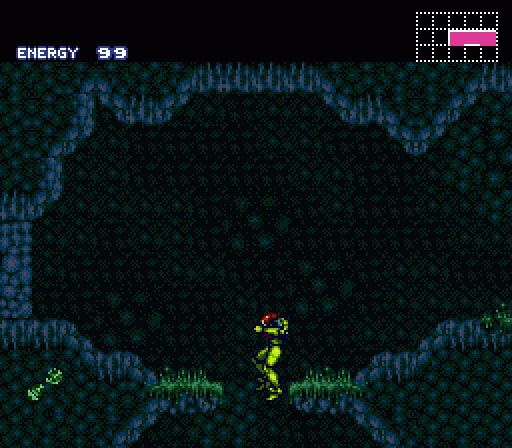
Inside the caverns, the sounds of rain fade away to be replaced by nothing save some atmospheric sounds. Despite ostensibly having entered the Space Pirates’ base, nothing here threatens Samus. Some trilobite-looking arthropods clinging to the cavern walls skitter away when you come near, but otherwise this area is utterly empty and silent. The roach-like native life gives the impression of abandonment and decay.
There’s only one path Samus can take for the moment — left and then down. Along the way you’ll notice a number of offshoot passages and routes (including a red missile door), but none of them are accessible for now. The one exception is a blue door in the left wall of this brief vertical shaft, but if you step through that you’ll find yourself thwarted again: It quickly dead-ends into a narrow one-block passage block by oddly marked stones. The only way forward is down.
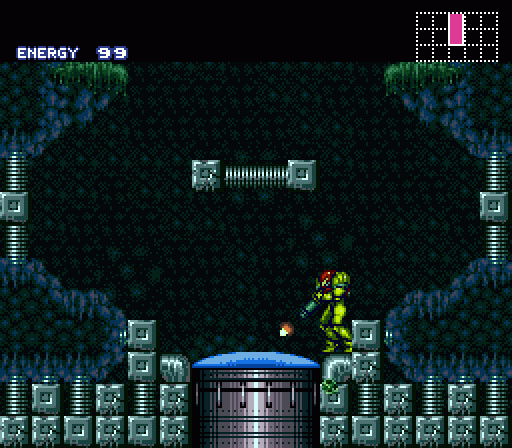
Something that remains true even when you reach the bottom of the shaft. For the first time in a Metroid game, you find a door bubble inset into the floor. This is no accident; Samus now has the ability to shoot at 45-degree angles as well as straight down. This gives her eight-way fire — something new in Super Metroid. The door here at the bottom of the entry passage inspires you to figure out how you can shoot downward, quietly giving you the opportunity to discover a technique without being obtrusive about it.
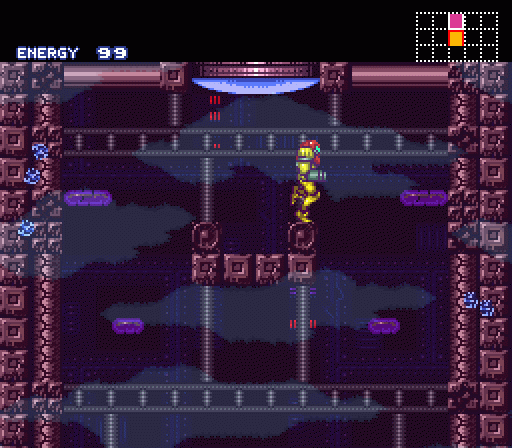
It also leads to this.
Metroid veterans will quickly recognize this shattered ruin of a vertical shaft: It’s the escape route from Metroid. The time bomb clearly exacted a toll on the fixtures here, as everything has a surface crazed with cracks, and a miasma of smoke clouds fills the air (evidently the time bomb wasn’t enough to break the airlock seal on the doors).
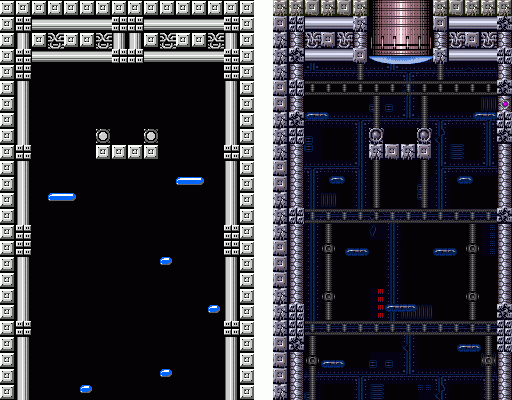
Yep, that’s a match.
So, Super Metroid has you infiltrating the Space Pirates’ lair through the bombed-out ruins of the escape route you took in the original game. It remains eerily silent here, and there are no signs of life larger than what you could kill by stepping on it with a good firm boot heel. We’ve seen this technique before in The Anatomy of a Game; not only did Zelda II have Link revisiting a tiny version of Hyrule, but Castlevania II used this precise trick for its finale in the ruins of Dracula’s castle.
Super Metroid‘s application of this trick, however, is easily the best of the bunch. It’s used as a prologue to set the tone of the game, and its eerie silence builds up to the eventual explosion of action. Plus, the sepia-tinted flashback sequence gave you the visual context you need to appreciate what you find in the room at the base of the dilapidated escape shaft…
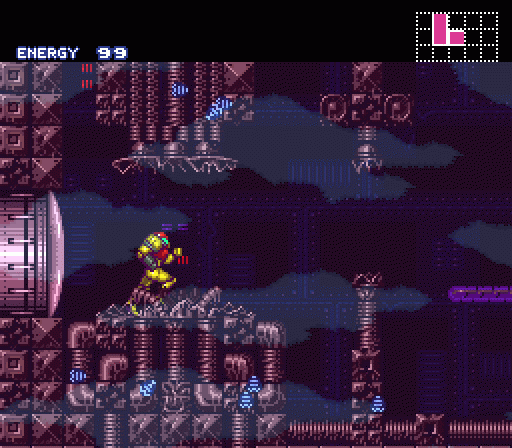
…namely, the shattered ruins of Mother Brain’s pedestal. Like the adjacent escape route, this room is a wreck, filled with a dense haze of old electrical smoke and populated with the broken fragments of the biomechanical super computer that used to occupy this chamber. Mother Brain’s former lair doesn’t lead back into the Tourian complex, though; the passage has been walled off, and now an elevator leads you down further into the planet.
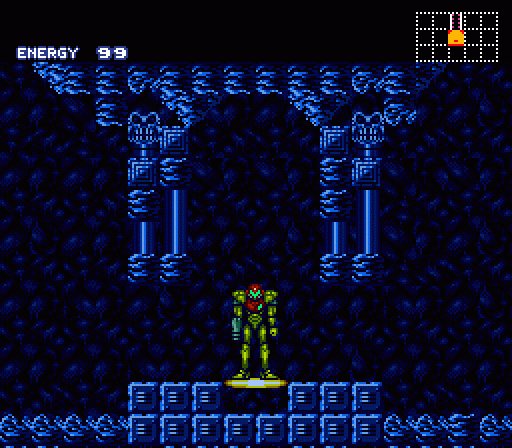
Specifically, it leads you into Brinstar, where you began the first Metroid odyssey. Despite your arrival in familiar grounds, however, the real action still doesn’t begin. Samus has yet to encounter any sort of threat or hazard despite descending ever further into the planet, through the ruins, into the well-preserved tunnels of the Space Pirates’ old lair. The creatures that formerly inhabited this section are nowhere to be found.
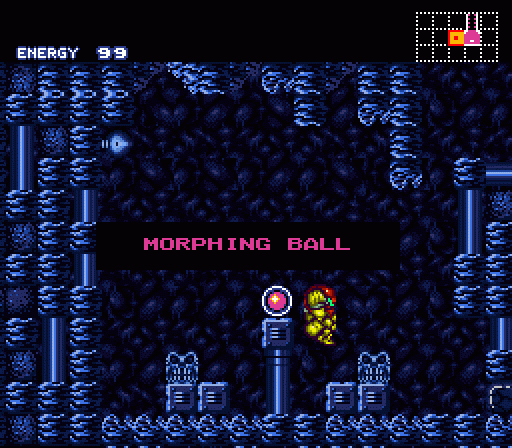
And, as before, the Maru Mari — now the Morphing Ball, because the term “morph” entered popular parlance between 1987 and 1994 (thanks, Michael Jackson’s “Black or White” video and Terminator 2!) — rests on a pedestal waiting for Samus to collect it. Now you can roll into a ball and make your way through the small bottom passage to the right, as in the original Metroid.
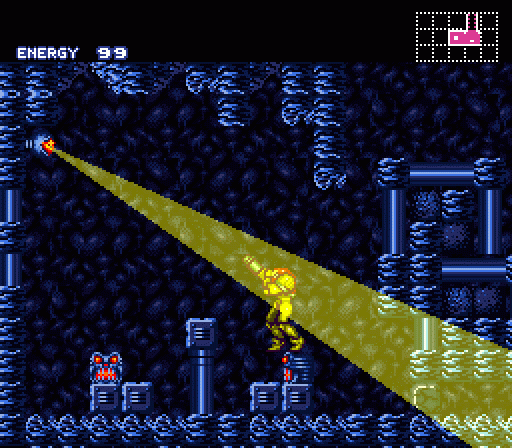
Unlike before, though, this time the Morphing Ball is rigged. As soon as Samus collects it, Brinstar begins to stir. Nothing attacks yet, but what happens is even more unnerving than mere combat. An eye-like spotlight flickers to life and fixes itself on Samus, tracking her motions. You can’t shoot the security monitor, though; all you can do is move away from it. Meanwhile, the stone faces inset in the base of the pedestal illuminate and rotate inward to face Samus, which might be even creepier.
The light will fade away if you move out of range, back to the right. Just like before, you have to roll under the one-way obstacle to the right with your newfound power, but this time you have to shoot out the fragile block obstructing the lower passage. Where this setup in Metroid taught you to use the ability to roll, here it also makes you realize you can fire at ground level by ducking but not tucking completely into Morph Ball form.
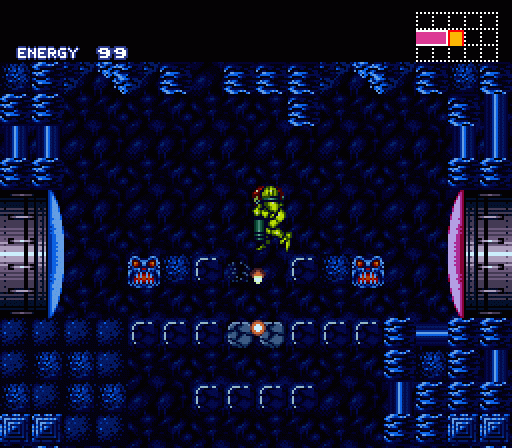
Continue to the right and you’ll find another familiar room, though here the far exit has been blocked off with a missile door. But that’s OK; unlike in Metroid, Samus can fire downward now, meaning that you no longer need the Bomb power-up to descend here. You can simply shoot out the floor and drop down. It’s a very clever use of a previously existing game structure to teach you about new abilities (or rather, to reinforce the previous lesson).
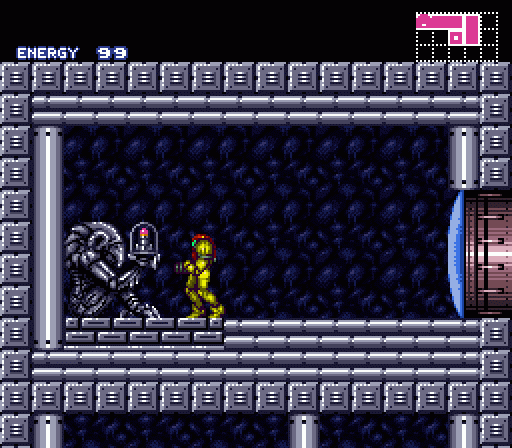
A short drop down, you’ll find your first missile, which you can then take back to the upper floor and use to break through that red door.
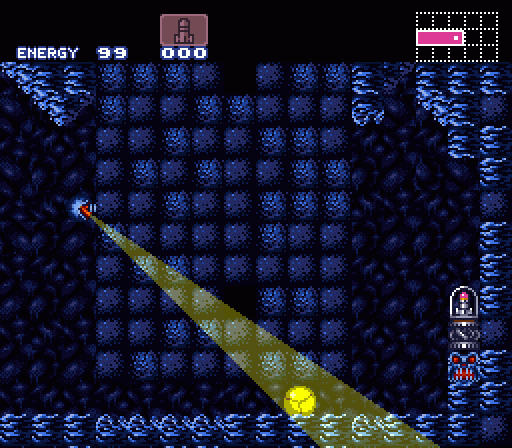
However, all you’ll find over here is another missile and a seeming dead end. And, again, a spotlight tracks Samus’ movements as she collects her power-up. At this point, there’s nowhere else to go in Brinstar, so it’s time to backtrack up to the surface of Zebes to apply these newly acquired skills to the beckoning passages you spotted on your way in.
The spotlight’s presence next to a second upgrade should make it clear that someone expected Samus to arrive, and they knew she’d make a beeline for the power-ups. In fact, it gives the unmistakeable impression that these weapons were left out as a bait to lure Samus into some sort of trap. As a final grace note, as you take the elevator back out of Brinstar, a second pair of rock faces set on either side of the lift turn to face Samus as she ascends.

And when you reach the ruins of Tourian, something has changed: The power has come back on, the miasma is gone, and the series’ ethereal “item room” tune plays.
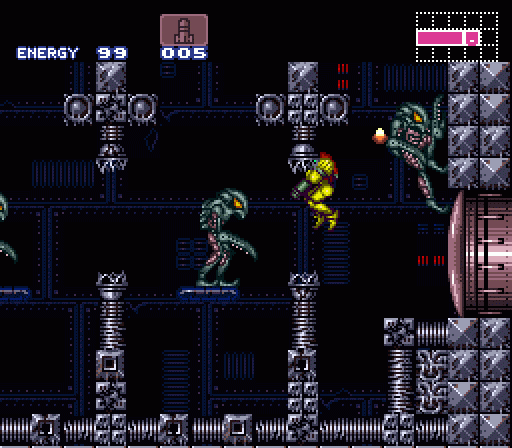
And Mother Brain’s old hangout is suddenly full of Space Pirates as the door locks behind you and an urgent but melancholic action theme begins to play. Surprise! Super Metroid has begun in earnest.
Honestly, words and images don’t do justice to the impact of this sequence. Super Metroid excels at maximizing minimal assets, and this introductory sequence demonstrates that artistry magnificently. It places you in familiar environments presented in an unusual way to build intrigue and suspense; the longer you play through this portion of the game, the more uneasy you become. That Ridley demo battle aside, Samus makes it several steps into the power-up progression chain before ever facing a single foe — but even as you work your way through desolation, it’s clear that you’re not alone on Zebes, nor unexpected. It’s absolutely one of the greatest playable introductory sequences in gaming, neatly translating the uneasiness of a horror film (or of Metroid‘s obvious inspiration, Aliens) before the monsters finally jump out and the action commences in earnest.
And the rest of the game is just as good.
Clearly I need to play this again. I thought I remembered it pretty well, but several of the amazing details in this intro are pretty fuzzy in my mind. This Anatomy is gonna be such a swell ride.
Someone once pointed out to me that Samus’ spaceship looks like a pair of sneakers. Cannot unsee.
This really makes me want to play through Super Metroid again. Not like that’s a bad thing admittedly.
The phrase “silent running” always makes me think of the Space Ghost: Coast to Coast episode where a gas leak makes Space Ghost loopy enough that he thinks the show is a murder mystery dinner party set on a submarine; several times he whispers “SILENT. RUNNING” to Moltar. Busta Rhymes was the guest, he just laughed the whole time.
Just me?
Anyway, Super Metroid is so great. The post-prologue opening is an excellent example of how to incorporate old game elements without coming across overly “fan service”-y. Also when I was a kid I always wondered if I could somehow jump quickly enough after grabbing the Morphing Ball to avoid the spotlight. Ha.
Super Metroid was my first Metroid game so the references to the first game were lost on me the first time playing. But the spotlight really stood out to me. My brother was watching me play and I said to him with a straight face “the aliens are alerted to my presence.” That small detail was sucking me into the game’s world, and ultimately sucking me into future Metroid fandom.
Another authentic detail is that although the first and last rooms of Metroid were not connected as they are in Super Metroid, they are almost adjascent, if the entire first game is put onto a single map.
I really love the first few steps into Zebes before things get chaotic. The lack of hostile life, the familiar old grounds of battles from the past, the camera eyes, the sudden ambush…While Metroid Fusion and MOM didn’t know how to shut up, Super Metroid says so much without saying a word at all.
I really like visual storytelling like this.
This intro sequence really gives lie to the notion that video games only work with action or adrenaline. The sedate exploration and ominous atmosphere are note-perfect; yet so few games dare to deviate from a pulse-pounding tone.
It also does a masterful job of indicating something that I didn’t see you explicitly call out: unlike the Ceres station, the terrain of Zebes will vary as you traverse it, and this is an important guide to both narrative and navigation. By introducing so much variety immediately, the game forces you to recognize this, I think.
I always wondered if the maps of the escape tunnel matched up exactly, but never really bothered to check. Too bad that they don’t. Oh well, probably for the best, considering.
One thing I always hoped was that if you did the Speed Booster’s duck-then-jump thing (was that the ShineSpark? I forget), you could go clear to the top. If that’s possible, I’ve never seen it.
“And, as before, the Maru Mari — now the Morphing Ball, because the term “morph” entered popular parlance between 1987 and 1994 (thanks, Michael Jackson’s “Black or White” video and Terminator 2!)”
Can’t help but think that one Mighty group of Rangers with Power might have had something to do with it, too. After all, Samus does do the henshin thing, too.
On another note, I’d love to hear opinions on something: I’ve seen it put forth that what made Metroid, maybe Metroid II so great was how challenging they were. This being something Super Metroid lacks, if only in relation to its predecessors, and is thus objectively not as good for it.
Personally, I prefer Super Metroid, but at the same time, I think if Metroid (not Zero Mission, mind) had an in-game map, rather than relying on guides or scribbling in notebooks, and at least refilled your life on a continue/password, the difference might not have been nearly as great.
“One thing I always hoped was that if you did the Speed Booster’s duck-then-jump thing (was that the ShineSpark? I forget), you could go clear to the top. If that’s possible, I’ve never seen it.”
You can, and you can also shinespark at a 45-degree angle to reach the secret passage on the upper-right long before you get the Space Jump. I’ve only managed to pull it off once, though.
The idea that something being more/less difficult than another game makes it OBJECTIVELY better/worse is utterly ludicrous.
Sorry, I meant subjectively. Gimme a break, it’s been a long day at the hospital. ;P
Have you noticed your traffic increasing? That’s me refreshing the site every 5 minutes waiting for those SM anatomy.
Nytetrain - I’ve never heard a human being claim Metroid or Metroid II were better than Super Metroid.
“You can, and you can also shinespark at a 45-degree angle to reach the secret passage on the upper-right long before you get the Space Jump. I’ve only managed to pull it off once, though.”
I think you mean upper-left? There is a room on the upper-right, but it’s not a secret.
Yeah, I meant upper left. Not sure why I typed “right.”
Just wondering, after your done doing Super Metroid can you maybe do some anatomys on non-nintendo titles? I agree that Nintendo makes great design decisions, but I think this project would get boring quicker if it does nothing but anatomy Miyamoto/Nintendo platformers.
I suspect I’m going to write whatever the hell I feel like writing. That’s my hunch.
Hi Jeremy. Fan and lurker: I’ve read and listened to you for years! Coincidentally, I’ve JUST replayed SM so this is exciting!
Parish: I wasn’t trying to negative with my comment, but I’d like for you to do a Kojima game or matsuno game. Or maybe games from other companies such as capcom or Konami and whatnot. Maybe even include some western made games.. I don’t see what’s so bad about some diversity from other design philiosophies from other developers.
Really enjoy the anatomy project.
I wasn’t being a jerk. It’s just that my methodology for this literally consists entirely of, “Hmm, what am I in the mood to write about?”
Thinking back, as a kid I never questioned that “space pirates” could be creatures instead of humans/humanoids. It is actually refreshing that the series kept that view. If it were made today, they would probably look like something out of Star Wars or Mass Effect.
Just sayin…
I’ve viewed your blog off and on over the years and noticed you always like kojima games, matsuno games, and even used to talk about games like Bionic Commando, Mega Man 2 (which i believe at one point in the past called your favorite game, along time ago) Crystalis, Gradius/etc. I’d like for you to try some of those games a t some point as I’d greatly appreciate you doing that. I’d even like you to delve into 3d games or gaming in general in the psx/saturn era.
I really enjoy this project a lot. Seeing as how i’m not to big on miyamoto, I would like for at some point when you feel like going into it to try doing the anatomy of some of your favorite other series and discussing those. Thanks for taking the time to reply to my previous comments and going into detail about why you didn’t care for the spider-ball in a comment I made the other day when you were doing this for Metroid 2. Appreciate it. Thanks for your time =)
You can get a sense of things I’d eventually like to cover at the main Anatomy page: http://www.2-dimensions.com/anatomy-of-a-game/
Looking over the list, would you ever consider doing Metal Gear and Snake’s Revenge for NES? People widely consider these to be the “bad” versions of Metal Gear, where things went “wrong”, but despite that, my dad and I enjoyed them when I was younger, and I’d like to see a critical analysis that looks at why these two aren’t as fondly remembered for many, and if they’re really “bad”, or just not as good as the originals.
Yeah, I looked at that knowing that it’s mostly by and large Nintendo stuff. Which is one of the reasons why I’;m commenting about this at the very start of your Super Metroid analysis. I just would like you to cover other games from other companies from other game creators. And even occasionally do more than just platform style games or even 2d games. I’d really like to see anaylsis of PSX games and Saturn games, which I believe in the past you said you were a fan of. Miyamoto’s games are probably the most analyzed games out there.
Again, just some recommendations I’d like too see you do as someone who reads your articles.
Man, those Samus sprites look GOOD. They are so well drawn and elegant.
Excellent write-up. If it weren’t for everything else on my plate, this would convince me to restart my long-fossilized attempt at LPing this game (for an exploration of the game’s stupidly and gloriously high skill ceiling).